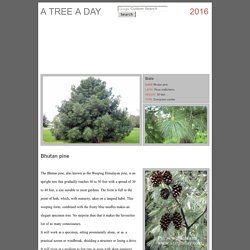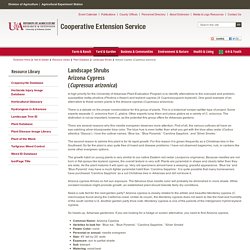

<i>Oxydendrum arboreum </i> SCIENTIFIC NAME: Oxydendrum arboreum COMMON NAME: sourwood, sorrel tree LEAVES: Alternate with a lanceolate shape.

Serrulate margins (very fine teeth). Excellent red fall color. Pointed at both ends. Leaves have a sour taste. Chamaecyparis obtusa 'Aurea' Golden Hinoki Cypress. Golden Vietnamese Cypress (Xanthocyparis vietnamensis) in Fayetteville Springdale Rogers Bentonville AR Arkansas AR at Westwood Gardens. Golden Vietnamese Cypress foliage (Photo courtesy of NetPS Plant Finder) * This is a "special order" plant - contact store for details.

Identification. Purple-leaf hazel. Here is a distinctive small tree, or large shrub, that produces stunning purple foliage that fades to green in summer.

It is the Purple-leaf hazel, or Corylus maxima ‘Purpurea’. This plant has been awarded the Royal Horticultural Society Award of Garden Merit. The RHS Award of Garden Merit is so difficult to come by that any plant so designated deserves a close look, and Purple-leaf hazel is just such a plant. This form of Hazel has beautiful, scalloped, heavily-textured leaves. And the opulent deep purple color rivals any other shrub of this shade. Catalpa bignoides ex aurea : Arrowhead Alpines. Chinese Yellow Catalpa. Chinese Yellow Catalpa. Yellow catalpa. Catalpa, or Catalpa bignonioides is a tree sometimes known as Indian bean tree.

It is native to the southeastern United States where Europeans first found the tree growing in the fields of the Cherokee tribes who called it Catalpa. However, its vitality enables it to flourish almost anywhere in the temperate world including southernmost Canada. Any Catalpa is a bold textural statement with four to eight inch leaves giving it a wonderful, coarse texture. And it has panicles of showy white flowers as long as twelve inches. From a distance they look like so many white bouquets covering the tree in late spring-early summer but closer inspection shows them to be individually complex and beautiful. The species grows 40 to 50 feet and has a lifespan of 60 years. Bhutan pine. The Bhutan pine, also known as the Weeping Himalayan pine, is an upright tree that gradually reaches 30 to 50 feet with a spread of 30 to 40 feet, a size suitable to most gardens.

The form is full to the point of lush, which, with maturity, takes on a languid habit. This weeping form, combined with the frosty blue needles makes an elegant specimen tree. No surprise then that it makes the favourites list of so many connoisseurs. It will work as a specimen, sitting prominently alone, or as a practical screen or windbreak, shielding a structure or lining a drive. It will grow at a medium to fast rate in areas with short summers that are not too hot, meaning it will thrive in the upper US, parts of Canada, the UK and temperate Australia and New Zealand. 7 Benefits of Robinia pseudoacacia ‘Frisia’ – Why I Changed My Scathing Review.
Several years ago I wrote an article titled ‘ Why I Won’t Plant Robinia pseudoacacia ‘Frisia‘ again : A Love Affair Gone Awry.

It was about how I fell in love with a Golden locust some 2o plus years ago when I first saw it in London. How I knew I was going to find a place in my garden for it at the right time and was able to do so after a major renovation. How I was swept away by my vision of what the end result would be. How I knew that the benefits of Robinia pseudoacacia ‘Frisia‘ would be numerous. Within a year after buying these 2-3’ tall leafless sticks from Gosslers Farms Nursery, the first 3 Robinias had become stars of the garden.
Will herbicide kill my trees? Arizona Cypress (Cupressus arizonica) A high priority for the University of Arkansas Plant Evaluation Program is to identify alternatives to the overused and problem-susceptible redtip photinia (Photinia x fraseri) and leyland cypress (X Cupressocyparis leylandii).

One good example of an alternative to these screen plants is the Arizona cypress (Cupressus arizonica). There is a debate on the proper nomenclature for this group of plants. This is a botanical lumper-splitter type of project. Some experts separate C. arizonica from C. glabra. PPWS 47 pdf. 430 026 pdf. Magnolia 'Apollo' Container grown conifers price list. Microbiota and Taiwania, the Small and the Large of it. Weeping Cedar of Lebanon. Published: December 20 2011 One of the grandest "big estate" conifers, cedar of Lebanon is also very happy to grow in compact gardens.

Here, it's swagging across the entrance into the gardens, like the lintel of a doorway. You can see it in the picture below, in back of the lintel formed by columnar parrotias. I'm growing four of the cedar of Lebanon's unusually flexible weeping cultivar. The trunks of the trees themselves are upright, but the branches droop gracefully. As each tree reaches the "lintel"—the pipe that's the top of a galvanized frame—I could start tying the young trunk horizontally. Here's the other side of the high galvanized-pipe frame that the cedars are topping, as it looked in mid-Summer. COLUMNAR IRONWOOD. Parrotia persica 'JLColumnar' Persian Spire™ PPAF - Persian Spire™ PPAF Persian Ironwood - Broken Arrow Nursery. Plant Delights Nursery. Acer palmatum 'Koto no Ito' - Koto no Ito Japanese Maple - All Plants - Broken Arrow Nursery. Dwarf Korean Lilac - Tree Form Standard. Peacock Horticultural Nursery Blog. New Conifers and a few types of deciduous trees arrived today @ Peacock Horticultural Nursery: A few of these new plants (all one gallon plants) that arrived today, are bit more on the unusual side @ Peacock Horticultural Nursery: Acer rufinerve ‘Winter Gold’ – A snake bark Maple to 20′ with golden bark.

Best in afternoon shade.Aesculus tubinata ‘Marble Chip’ – Variegated Japanese Horse Chestnut – Large, creamy white and green variegated leaves. This selection is supposed to be more scorch resistant than some of the other variegated forms.Betula pendula ‘Golden Cloud’ – Birch with butter-yellow leaves in the spring. Planting a Tree or Shrub - TNArboretum. 1.

Choose the proper planting time.A. In warmer climate zones (about zone 5 or 6 and higher) where the ground doesn't commonly stay frozen through most of the winter, most trees and shrubs can be planted at anytime between mid fall (after leaf drop) and early spring (before bud-break) as long as the ground is not frozen. Fall is probably the optimal time for many trees and shrubs because the root system has a longer time to become established before the plant has to deal with the stress of summer heat. Potted plants which are not potbound, and therefore do not require significant root manipulation, can be planted even in mid summer without much risk. Shagbark Hickory Trees Grown for More Than Just Nuts. A species indigenous to North America, shagbark hickory trees are widespread in the Eastern U.S. in zones 4-8. They are related to the pecan, another native American nut bearer. Although they can reach a height of 130 feet in some portions of their range, these popular nut trees often reach only about half that size.
They grow in full to partial sun. Pistacia chinensis 'Keith Davey' Ulmparb. FRANKLINIA alatamaha – Southern Living. This legendary tree, native to the banks of Georgia's Alatamaha River, mysteriously disappeared from the wild shortly after it was discovered there in 1770 by famed botanist John Bartram. All plants in commerce today can be traced to the ones he collected. Open, airy form; may reach 30 feet but more typically grows 1020 feet high. STEWARTIA – Southern Living. These slow-growing plants are all-season performers that show off fresh green leaves in spring, white flowers resembling single camellias in summer, and colorful foliage in fall.
Winter reveals a distinctive pattern of bare branches and smooth bark that flakes off in varying degrees, depending on species. All grow best in well-drained, acid soil with lots of organic matter. Good in woodland gardens and as foreground specimens against a backdrop of larger, darker-leafed trees. silky stewartia. Stewartia. Stewartias are specimen quality trees that are native to Japan, Korea, and the southeastern U.S.
All are slow-growing, all-season performers that show off fresh green leaves in spring, white flowers resembling single camellias in summer, and colorful foliage in autumn. Exfoliating bark creates a beautiful spectacle in winter after leaves fall. Stewartias look wonderful in woodland settings or placed as specimens against darker backgrounds. Will Roundup kill my trees? Spring Tree Service Checklist. When winter woes bring you down, think spring! Plan for a happy, healthy growing season using the 5 tips below. Tree fertilization - A guide for fertilizing new and established trees in the landscape : Yard and Garden : Garden : University of Minnesota Extension.
The Pfanner Monkey Beaver Man. The Pfanner Monkey Beaver Man. Watering trees and shrubs. Skip to main content. Pinus thunbergiana ' Thunderhead ' Japanese Black Pine - Kigi Nursery. Best method to plant a tree or shrub! Peacock Horticultural Nursery Blog. Silver splash silverbell tree. "Alniphyllum fortunei" Root Collar Inspections. Two of the biggest problems in the landscape today are planting too deep and over mulching. Tree roots breath, there is a gaseous exchange of elements at the root system.
Mulch Can Kill Trees. Elisabeth C. Miller Library: Gardening Answers Search Results for "2522" BlueBell Nursery - BlueBell Nursery - Trees & Shrubs - Embothrium - Embothrium coccineum var. lanceolata. Acer rubrum 'Florida Flame' Red Maple 'Florida Flame' from Woodlanders, Inc. Ashe's Magnolia. The Magnolia world is far-flung and teaming, with over a thousand forms arising just from other cultivars. In addition, there are the many scores of species, which are native to North and South America as well as Asia, from the Himalaya southeastward through Indonesia and the Philippines, then north though Vietnam, China, and Japan. Goshen Gardens » News. River Road Farms. Styrax japonicus ( Japanese Snowbell )
2015 Inventory of Apple Trees - Bonnie Blue Farms and Nursery. The Satsuma is the Best Home Citrus for Zone 8+ - Bonnie Blue Farms and Nursery. There is no Spoon. Breaking all the Tree Planting Rules - Bonnie Blue Farms and Nursery. Chinese chestnut tree. Chinese chestnut tree. Dr. Carl Whitcomb, Improving Plant Root Systems. Root Systems Basics. Products - American Persimmon - Grimo Nut Nursery.
Shellbark Hickory on the Tree Guide at arborday.org. Products - Grimo Nut Nursery. Shagbark Hickory – the tree that keeps on giving. Shagbark hickory trees (Carya ovata) are well known to be desirable for shade, fall color, tasty nuts, and desirable timber, but perhaps their most valuable use is not well known. Mature shagbark hickory trees are natural roost sites for bats, and especially desirable as maternity roosts. Quality roost sites are key to maintaining and increasing a bat population, which in turn provides an effective natural control of mosquitoes and other night flying pests.
A bat house generally consists of one or more narrow chambers into which the bat may enter at the bottom, placed in a location with ample solar heating and reasonable protection from predators. A well pruned shagbark hickory essentially makes bat houses on the sides of the trunk. The bark “shags” off at the top and bottom leaving the middle quite firmly attached. Shagbark hickories have a large tap root that makes it difficult to transplant after the tree is more than 2 or 3 years old.
Growth is initially very slow. 1. Rich's Foxwillow Pines Nursery, Inc. - Cercidiphyllum japonicum – 'Pendula'Weeping Katsura Tree. Rich's Foxwillow Pines Nursery, Inc. - Acer griseum – Paperbark Maple. Rich's Foxwillow Pines Nursery, Inc. - Sciadopitys verticillata – 'Joe Kozey'Japanese Umbrella Pine. RFWP Specimen Trees Retail. Sciadopitys verticillata ‘Joe Kozey’ Pinus cembra. Pinus cembra. Beloved conifers: recap of coziest woody plants.
Beloved conifer: japanese umbrella pine. The World's Best Gardening Blog. Katsura japonicum amazing grace. Katsura japonicum amazing grace. The Tree that Smells like Cotton Candy, Burnt Sugar, or Cookies. The World's Best Gardening Blog. The World's Best Gardening Blog. Sassafras on the Tree Guide at arborday.org. Ginkgo biloba Magyar Conifer Record.
Ginkgo biloba 'Magyar' Monkey puzzle tree pictures. Monkey Puzzle Tree for Sale. Goldenraintree on the Tree Guide at arborday.org. Flowering Apricot One Of The First Trees To Bloom - Mecklenburg Extension Master Gardener Volunteers. JC Raulston Arboretum - Prunus mume. Yuan Shan Hardy Schefflera. Great Plant Picks. Frisia golden locust tree. Sheepberry Tree. Pawpaw Planting Guide. Paw Paw Perfection. White tigress snakebark fall color. Liquidambar styraciflua, American Sweetgum - Plant Database - University of Connecticut. Acer griseum Paperbark Maple. Cercidiphyllum 'Amazing Grace' (Katsura tree) - Trees & Shrubs.